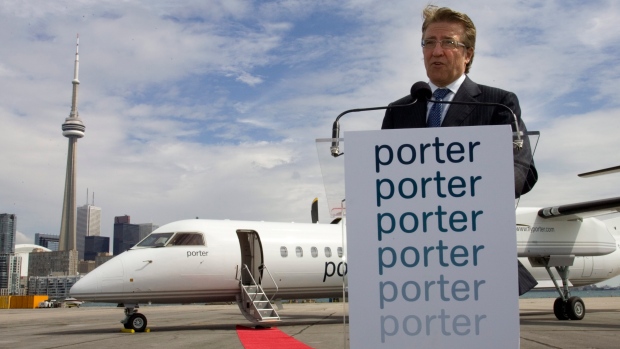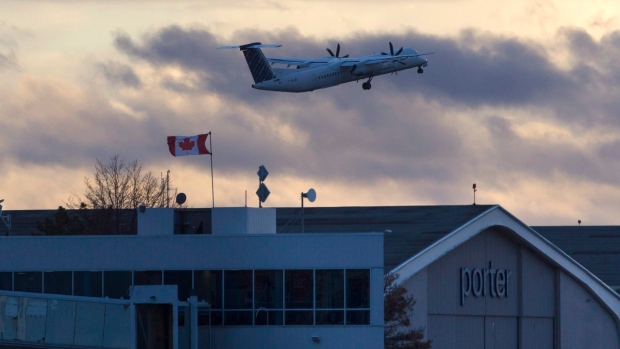Oct 21, 2016
Porter Airlines' growth in question as scrappy airline turns 10
By Paige Ellis

Porter Airlines’ mascot of a raccoon – an animal known for being both persistently clever and resourceful – was aptly chosen.
From a startup with two turboprop planes and a promise to bring “service and sophistication” back to flying, the scrappy airline beat the odds to become a bona fide rival of Air Canada (AC.TO) and WestJet (WJA.TO).
But with the company’s plans to extend Toronto’s island airport blocked by the federal government, experts say Porter’s future is foggy.
“Porter has done well by exploiting a unique asset, Billy Bishop [Toronto City Airport],” wrote David Tyerman, a transportation and industrial products analyst at Cormark Securities, in an email to BNN. “It is hard to see how they grow substantially from here.”
ISLAND MONOPOLY
The airline, which celebrates its 10th anniversary this month, bought Billy Bishop’s airport terminal from the local port authority in 2005. Months later, it booted its competition -- Jazz Aviation -- off the island.
Porter was in an unprecedented and enviable position: the carrier enjoyed a virtual monopoly of Toronto’s convenient downtown airport before its first plane left the tarmac.
The service quickly caught on with business travelers and, as business grew, Porter added more planes to its fleet and routes to its flight map.
But by 2013, the company’s network was nearly tapped, according to Chris Murray, an analyst at AltaCorp.

A Porter Airlines plane takes off from Toronto's Island Airport. (The Canadian Press/Chris Young)
“They tried most feasible destinations [from the island airport],” he notes, adding turboprops have a maximum 500-mile radius.
So scrappy Porter came up with a new plan: expand its main hub in order to expand its business.
The carrier requested permission to extend Billy Bishop’s airport runway by 168 meters in each direction. It also requested permission to fly Bombardier CS100 jets out of the island airport, enabling the company to fly to places like Vancouver and Los Angeles.
“We believe opening up these new, longer-range destinations will have a positive effect on Toronto’s economy and competiveness, stimulating new business and tourism interest in our city,” Porter CEO Robert Deluce said at the time.
The proposal was greeted with fierce opposition by some local politicians and community groups, concerned about safety, noise and the plan’s environmental impact.
In 2015, Ottawa shelved Porter’s plan with two simple tweets.
Despite the federal government’s decision, Deluce believes his company remains well positioned for growth.
“We are very focused on Billy Bishop Toronto City Airport as our main core,” he told BNN in an interview on Thursday. “Having said that, there are also some growth opportunities that are available to us from other focus cities, such as Halifax, Montreal and Ottawa.”
Deluce is also optimistic U.S. customs preclearance will soon be available at the island airport.
“That opens up maybe, potentially, a second airport in New York and maybe a downtown airport in Washington. Those would all be welcome additions, I think, to our Toronto and area travelers wanting downtown-to-downtown flying capability.”
WHAT'S NEXT FOR PORTER
Analysts say it’s unlikely Porter will be able to replicate the growth it saw in its first 10 years without expanding the runway.
Murray argues the company could consider setting up a “mini-Porter” hub in western Canada, but that would come with a whole new set of challenges.
“The Q400 is ideally suited for that kind of operation,” he said. “But then it would be a standalone. How would you connect the [eastern and western] networks?”
Without a robust growth plan, an initial public offering would be a “tough sell” for investors, according to Cormark’s Tyerman.
Porter floated the idea of an IPO in 2010 but later scrapped the idea due to unfavorable market conditions. Deluce has previously told BNN he believes an IPO is “inevitable.”
Nonetheless, Robert Kokonis, an airline consultant and co-founder of AirTrav, argues Porter should never be underestimated.
“They are still around 10-years in,” he told BNN by phone. “With airlines, failures tend to happen two years in.”




